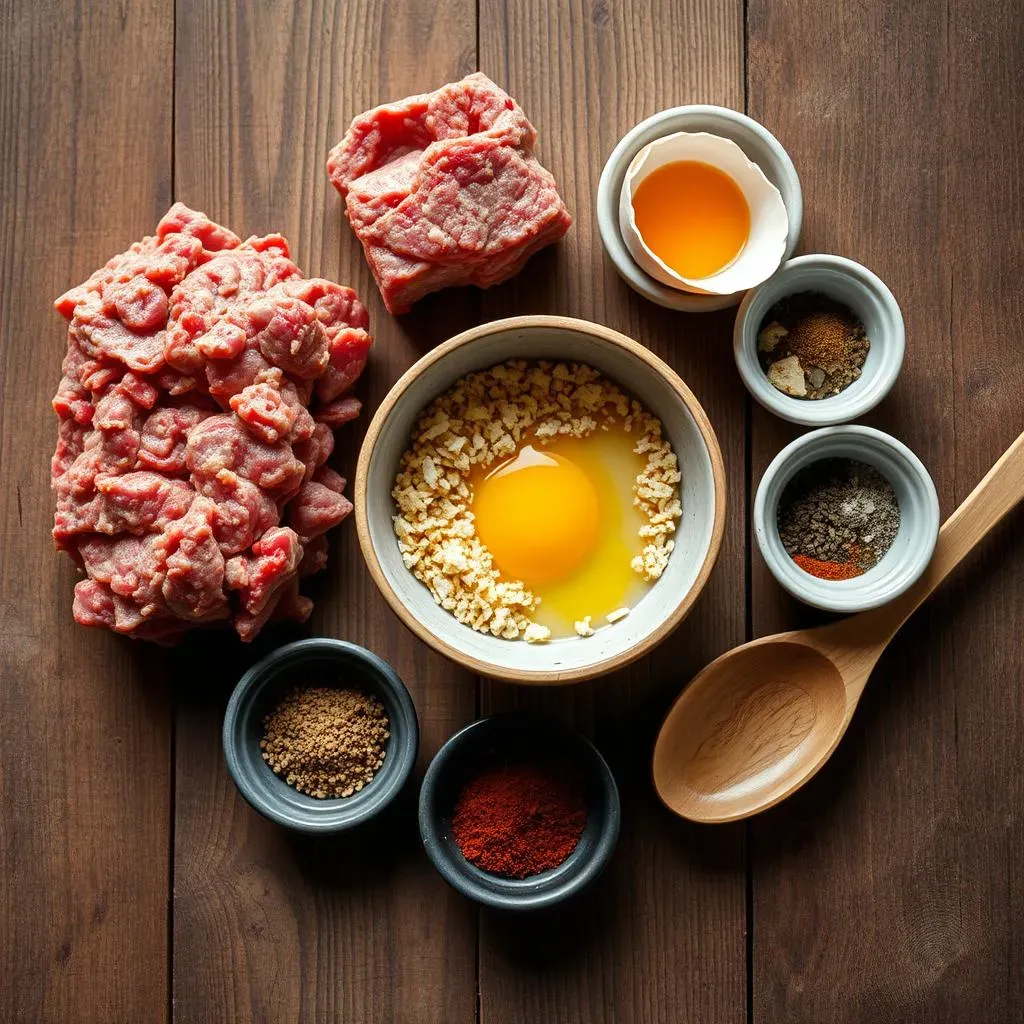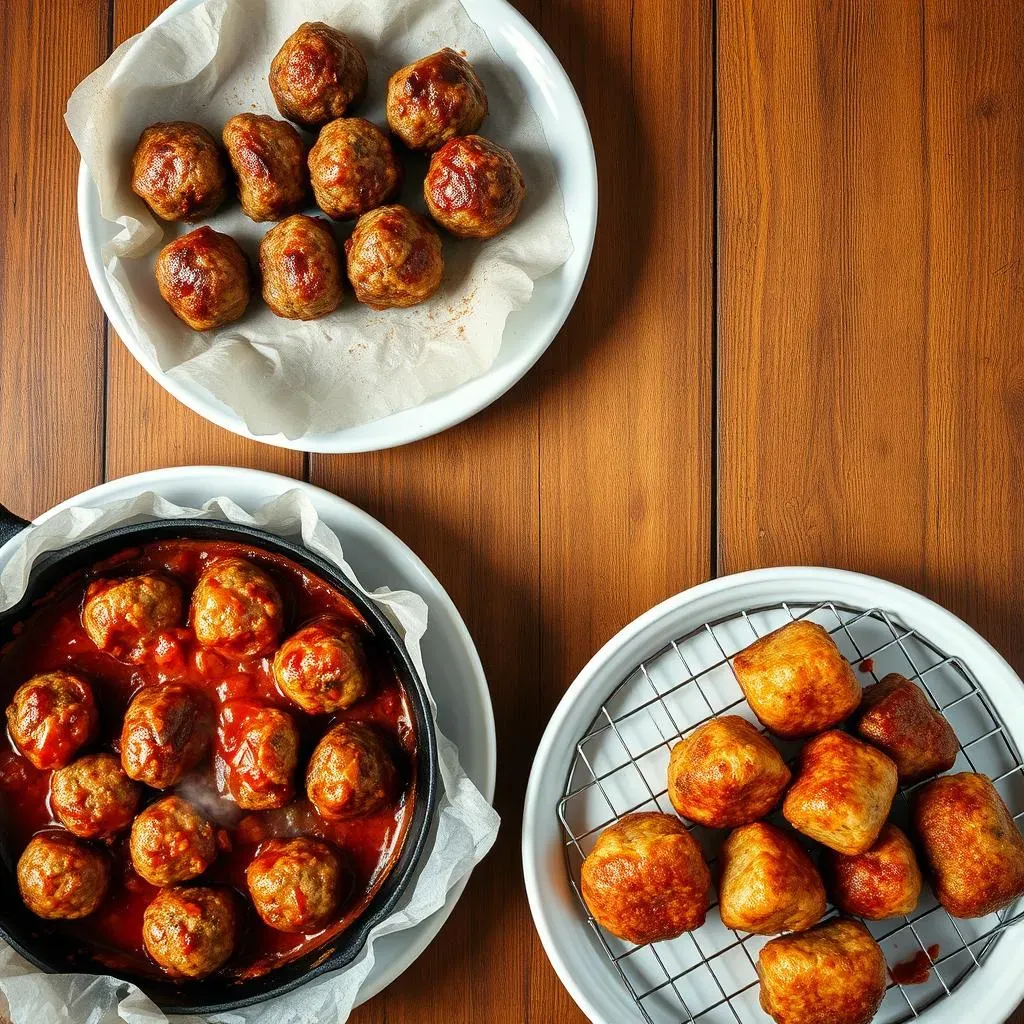Craving that comforting taste of homemade Italian cooking? It all starts with perfectly crafted meatballs. Forget the store-bought, dry hockey pucks – making homemade meatballs is surprisingly easy and incredibly rewarding. This guide will walk you through every step, from selecting the right ground meat to mastering the art of seasoning, binding, and cooking your meatballs to juicy perfection. We'll explore different cooking methods, whether you prefer the hands-off approach of oven-baking or the rich flavor of simmering them directly in your favorite sauce. Plus, we'll share some creative serving suggestions to elevate your meatball game. So, roll up your sleeves, gather your ingredients, and get ready to unleash your inner Italian chef. By the end of this article, you'll have the knowledge and confidence to create mouthwatering meatballs that will impress your family and friends. Let's get started on making homemade meatballs that are bursting with flavor and guaranteed to become a family favorite!
The Secret to Juicy Homemade Meatballs: Choosing Your Ground Meat

The Secret to Juicy Homemade Meatballs: Choosing Your Ground Meat
The Blend is Your Friend
Alright, let's talk meat – the foundation of any great meatball. Forget using just one type of ground meat. The real magic happens when you blend! A mix of ground beef and Italian sausage is my go-to. The beef gives you that classic meatball flavor, while the sausage adds a ton of richness and spice. Think about it: the fat content in sausage is higher, which translates to juicier meatballs. Trust me, this combo is a game-changer.
But don't just grab any ground beef! The fat percentage matters. I usually aim for an 80/20 blend (80% lean, 20% fat). Too lean, and your meatballs will be dry and crumbly. Too fatty, and they'll shrink up and be greasy. Finding that sweet spot is key. And when it comes to sausage, sweet Italian sausage is a safe bet for most palates, but feel free to experiment with hot or even a little fennel sausage for extra depth.
Beyond Beef and Sausage: Exploring Other Options
so beef and sausage are my staples, but don't let that limit you! There's a whole world of ground meat possibilities out there. Ground pork is a fantastic option – it's got a great flavor and a good amount of fat to keep things juicy. You could even try a blend of ground beef, pork, and veal for a truly classic Italian meatball experience. Veal adds a delicate sweetness that's really special.
And for those looking for a lighter option, ground turkey or chicken can work too. But here's the thing: they tend to be leaner, so you'll need to compensate with extra moisture. Try adding some grated zucchini or a little bit of ricotta cheese to keep them from drying out. Just remember, the goal is juicy, flavorful meatballs, no matter what kind of meat you use!
Meat Type | Fat Content | Flavor Profile | Tips for Juicy Meatballs |
|---|---|---|---|
Ground Beef (80/20) | Medium | Classic, Beefy | Excellent choice, naturally juicy. |
Italian Sausage | High | Rich, Spicy, Savory | Adds great flavor and moisture. |
Ground Pork | Medium-High | Mild, Slightly Sweet | Good alternative, keeps meatballs moist. |
Ground Turkey/Chicken | Low | Lean, Mild | Add grated zucchini or ricotta for moisture. |
Spice It Up: Flavoring Your Homemade Meatballs Like a Pro

Spice It Up: Flavoring Your Homemade Meatballs Like a Pro
The Italian Herb Trinity: Garlic, Parsley, and Oregano
now for the fun part: flavor! This is where you can really make your meatballs sing. And when it comes to Italian meatballs, there's a holy trinity of herbs you absolutely need: garlic, parsley, and oregano. Freshly minced garlic is a must – don't even think about using the jarred stuff. It just doesn't have the same punch. And for parsley, I always go with fresh flat-leaf (Italian) parsley. It's got a brighter, cleaner flavor than the curly kind. As for oregano, you can use fresh or dried, but if you're using dried, make sure it's not ancient! Spices lose their potency over time, so give it a sniff – if it doesn't smell like oregano, it's time to toss it.
But don't just throw these herbs in willy-nilly! The key is to get the balance right. Too much garlic, and your meatballs will be overpowering. Not enough parsley, and they'll be bland. I usually start with a tablespoon of minced garlic, a quarter cup of chopped parsley, and a teaspoon of oregano for every pound of meat. But taste as you go! That's the beauty of cooking – you can adjust the flavors to your liking. And don't be afraid to experiment with other herbs too, like basil, thyme, or even a little rosemary.
Beyond the Basics: Adding Depth and Complexity
Once you've nailed the herb trinity, it's time to think about adding some extra layers of flavor. A little bit of grated Parmesan cheese is a classic addition. It adds a salty, umami richness that's hard to resist. And speaking of umami, a splash of Worcestershire sauce can also do wonders. It's got that savory, slightly tangy flavor that really deepens the overall taste of the meatballs. Another trick I love is adding a pinch of red pepper flakes for a little bit of heat. It doesn't make the meatballs spicy, but it adds a subtle warmth that's really nice.
And don't forget about salt and pepper! Seasoning is crucial for bringing out all the other flavors. I always use kosher salt and freshly ground black pepper. The kosher salt is less salty than table salt, so you can use more of it without oversalting. And freshly ground pepper has a much more complex flavor than pre-ground pepper. Just remember to taste your meatball mixture before you start cooking, and adjust the seasoning as needed. You want the flavors to be bold and balanced, so don't be shy!
Ingredient | Amount per Pound of Meat | Flavor Contribution |
|---|---|---|
Minced Garlic | 1 Tablespoon | Pungent, Aromatic |
Chopped Fresh Parsley | 1/4 Cup | Bright, Fresh |
Oregano (Fresh or Dried) | 1 Teaspoon | Earthy, Savory |
Grated Parmesan Cheese | 1/4 Cup | Salty, Umami |
Worcestershire Sauce | 1 Teaspoon | Savory, Tangy |
Red Pepper Flakes | Pinch (to taste) | Subtle Heat |
Kosher Salt | 1 Teaspoon | Enhances Flavors |
Freshly Ground Black Pepper | 1/2 Teaspoon | Adds Depth |
Binding It All Together: Breadcrumbs, Eggs, and Other Essentials for Making Homemade Meatballs

Binding It All Together: Breadcrumbs, Eggs, and Other Essentials for Making Homemade Meatballs
The Role of Breadcrumbs: More Than Just Filler
so you've got your meat and your spices, but how do you actually hold these meatballs together? That's where breadcrumbs and eggs come in. Breadcrumbs aren't just filler – they play a crucial role in giving your meatballs a light, tender texture. They absorb moisture and prevent the meatballs from becoming dense and rubbery. But not all breadcrumbs are created equal. I prefer using panko breadcrumbs because they're light and airy, and they don't get soggy as easily as regular breadcrumbs. You can also use fresh breadcrumbs, which you can make by pulsing day-old bread in a food processor. Just make sure they're not too dry, or they'll suck up all the moisture from the meat.
Now, how much breadcrumbs should you use? I usually start with about a half cup of breadcrumbs per pound of meat. But it really depends on the consistency of your meat mixture. You want it to be moist but not soupy. If it's too wet, add more breadcrumbs. If it's too dry, add a little bit of milk or water. And here's a pro tip: soak your breadcrumbs in milk or broth before adding them to the meat mixture. This will help them absorb even more moisture and create even more tender meatballs.
Eggs: The Unsung Hero of Meatball Construction
Eggs are another essential ingredient for binding your meatballs. They act as a glue, holding everything together and preventing the meatballs from falling apart during cooking. But just like with breadcrumbs, the amount of eggs you use is crucial. Too many eggs, and your meatballs will be tough and rubbery. Not enough eggs, and they'll crumble apart. I usually use one large egg per pound of meat. But again, it depends on the consistency of your meat mixture. If it's really wet, you might need to add an extra egg. If it's really dry, you might need to add a little bit of milk or water.
And here's a little secret: whisk your egg before adding it to the meat mixture. This will help it distribute more evenly and prevent clumps of egg from forming in your meatballs. You can also add a little bit of grated Parmesan cheese to your egg mixture. This will add extra flavor and help the meatballs bind together even better. Just remember to be gentle when mixing everything together. Overmixing will make your meatballs tough. You want to mix everything just until it's combined. And then, you're ready to start rolling!
Ingredient | Amount per Pound of Meat | Function | Tips |
|---|---|---|---|
Panko Breadcrumbs | 1/2 Cup | Absorbs moisture, adds texture | Soak in milk or broth for extra tenderness. |
Large Egg | 1 | Binds ingredients together | Whisk before adding to the meat mixture. |
Milk/Broth | As needed | Adds moisture | Add gradually until the mixture is moist but not soupy. |
Grated Parmesan Cheese | Optional | Adds flavor and helps bind | Add to the egg mixture for even distribution. |
Cooking Methods: From OvenBaked to Simmered in Sauce for Your Homemade Meatballs

Cooking Methods: From OvenBaked to Simmered in Sauce for Your Homemade Meatballs
Oven-Baked: Hands-Off and Healthy
let's talk cooking methods. First up, we have oven-baking. This is my go-to when I want a hands-off approach. It's super easy – just pop the meatballs in the oven and let them do their thing. Plus, it's a healthier option since you're not frying them in oil. To oven-bake your meatballs, preheat your oven to 375°F (190°C). Then, line a baking sheet with parchment paper. This will prevent the meatballs from sticking and make cleanup a breeze. Arrange the meatballs on the baking sheet, making sure they're not touching. Bake for about 20-25 minutes, or until they're cooked through and golden brown. And here's a little tip: flip the meatballs halfway through cooking to ensure they cook evenly on all sides.
But here's the thing about oven-baking: it can sometimes result in drier meatballs. To combat this, I like to add a little bit of water or broth to the baking sheet. This will create some steam in the oven and help keep the meatballs moist. You can also brush the meatballs with a little bit of olive oil before baking. This will help them brown nicely and add some extra flavor. And if you're really worried about dryness, you can bake the meatballs in a sauce. Just pour some of your favorite tomato sauce over the meatballs before baking. This will keep them super moist and flavorful.
Stovetop Simmered: Maximum Flavor Infusion
Now, if you're looking for maximum flavor, stovetop simmering is the way to go. This method allows the meatballs to soak up all the deliciousness of your sauce. To simmer your meatballs, start by browning them in a skillet with a little bit of olive oil. This will give them a nice crust and add some extra flavor. Don't overcrowd the skillet – brown the meatballs in batches if necessary. Once the meatballs are browned, add your favorite tomato sauce to the skillet. Bring the sauce to a simmer, then reduce the heat to low, cover the skillet, and let the meatballs simmer for at least an hour. The longer they simmer, the more flavorful they'll be. And here's a pro tip: stir the meatballs occasionally to prevent them from sticking to the bottom of the skillet.
But be careful not to overcook the meatballs! Overcooked meatballs will be tough and dry. You want them to be tender and juicy. To test for doneness, insert a thermometer into the center of a meatball. It should register 160°F (71°C). If you don't have a thermometer, you can cut into a meatball to check. It should be cooked through but still slightly pink in the center. And here's another tip: if your sauce starts to get too thick, add a little bit of water or broth to thin it out. You want the sauce to be thick enough to coat the meatballs, but not so thick that it's gloppy.
Cooking Method | Pros | Cons | Tips |
|---|---|---|---|
Oven-Baking | Hands-off, healthy, easy cleanup | Can be drier | Add water/broth to the baking sheet, brush with olive oil, bake in sauce. |
Stovetop Simmering | Maximum flavor, tender meatballs | Requires more attention, can be overcooked | Brown meatballs before simmering, simmer on low heat, stir occasionally. |
Deep Fried: For a Crispy Treat
Want to make a crispy treat? Consider deep frying. While this isn't the healthiest option, it's fantastic for achieving a crispy exterior. Heat oil to 350°F (175°C) in a deep fryer or large pot. Carefully drop meatballs into the hot oil, ensuring not to overcrowd. Fry until golden brown and cooked through, about 5-7 minutes. Remove and place on a wire rack to drain excess oil. These are excellent as appetizers or added to dishes where a crispy texture is desired.
Serving Suggestions: Elevate Your Meal with These Homemade Meatball Pairings

Serving Suggestions: Elevate Your Meal with These Homemade Meatball Pairings
Classic Comfort: Spaghetti and Meatballs, Reimagined
let's be real, spaghetti and meatballs are a classic for a reason. But that doesn't mean we can't jazz it up! Instead of just plopping your meatballs on top of a pile of spaghetti, try tossing them with the pasta and sauce in a skillet. This will help the meatballs absorb even more flavor and create a more cohesive dish. And don't be afraid to get creative with your sauce! A simple marinara is always a winner, but you could also try a creamy pesto sauce, a spicy arrabiata sauce, or even a rich mushroom sauce. The possibilities are endless!
And if you really want to take your spaghetti and meatballs to the next level, try adding some fresh herbs and grated Parmesan cheese. A sprinkle of basil, oregano, or parsley will add a burst of freshness, while a generous grating of Parmesan will add a salty, umami richness. You can also add some vegetables to your spaghetti and meatballs. Sautéed onions, peppers, and mushrooms are all great additions. Just remember to cook the vegetables before adding them to the sauce, so they don't get mushy.
Beyond Pasta: Creative Meatball Creations
While spaghetti and meatballs will always hold a special place in my heart, there's a whole world of meatball possibilities beyond pasta. Think meatball subs with melted mozzarella cheese and a tangy marinara sauce. Or how about meatball sliders with a sweet and savory glaze? You could even add your meatballs to a hearty minestrone soup for a protein-packed meal. And for a fun appetizer, try serving your meatballs with a creamy dipping sauce, like a garlic aioli or a pesto mayo.
And don't forget about global flavors! Meatballs are incredibly versatile and can be adapted to suit any cuisine. Try making Greek-style meatballs with feta cheese and oregano, and serving them with a lemon-yogurt sauce. Or how about Asian-inspired meatballs with soy sauce, ginger, and garlic, and serving them with a sweet chili sauce? The only limit is your imagination! So, get creative and have fun experimenting with different flavors and serving suggestions. Your taste buds will thank you!
Serving Suggestion | Description | Flavor Profile |
|---|---|---|
Spaghetti and Meatballs | Classic dish with pasta and tomato sauce | Comforting, Familiar |
Meatball Subs | Meatballs in a submarine sandwich with cheese and sauce | Hearty, Satisfying |
Meatball Sliders | Mini meatball sandwiches with a glaze | Sweet and Savory |
Minestrone Soup with Meatballs | Hearty vegetable soup with added meatballs | Wholesome, Nutritious |
Meatballs with Dipping Sauce | Meatballs served as an appetizer with various sauces | Versatile, Customizable |
Homemade Meatball Mastery: A Delicious Ending
So, there you have it – a complete guide to making homemade meatballs that are far from ordinary. From selecting the perfect meat blend to experimenting with flavors and mastering your preferred cooking method, you're now equipped to create a meatball masterpiece every time. Whether you serve them atop a bed of spaghetti, nestled in a toasted sub, or as a standalone appetizer, these homemade delights are sure to be a crowd-pleaser. Don't be afraid to get creative and personalize your recipe to suit your taste preferences. The most important thing is to have fun and enjoy the process. Happy cooking, and may your future be filled with delicious, homemade meatballs!